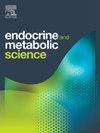Distribution of norepinephrine and acetylcholine receptors in ovarian structures across reproductive and senescent phases in rats
Q3 Medicine
引用次数: 0
Abstract
The autonomic nerves in the mammalian ovary are responsible for transmitting the neurotransmitters norepinephrine and acetylcholine, among others. Interestingly, some ovarian innervation becomes more active toward the end of life. The objective of this study was to examine the presence of adrenergic (A1R) and muscarinic (M1R) receptors in adult and senescent female rats. Female rats were divided into three groups according to age: young adults aged 3 to 5 months (3M), middle-aged rats aged 12 months (12M), and senescent rats aged 15 months (15M). Primary antibodies targeting the α1-adrenergic receptor, μ1-muscarinic receptor, 17β-estradiol receptor (ER), and α1-progesterone receptor (PR) were used. Immunoreactivity analysis covered the ovarian stroma and cells around functional structures such as the corpus luteum, ovarian cysts, and follicles. Both receptor antibodies stained these structures, but the noradrenergic binding was three times more abundant than cholinergic binding. The number of immunoreactive cells expressing the A1R/ER combination was significantly increased in 12M rats, principally around follicles or cysts. M1R/PR staining was similarly increased in the 12M group, but the principal signal source was the stroma cells. The autonomic nervous system appears to participate in the loss of function of these structures with age in the rat ovary.
大鼠生殖期和衰老期卵巢结构中去甲肾上腺素和乙酰胆碱受体的分布
哺乳动物卵巢中的自主神经负责传递去甲肾上腺素和乙酰胆碱等神经递质。有趣的是,一些卵巢神经支配在生命末期变得更加活跃。本研究的目的是检测成年和衰老雌性大鼠肾上腺素能(A1R)和毒蕈碱(M1R)受体的存在。雌性大鼠按年龄分为3 ~ 5月龄青壮年组(3M)、12月龄中年大鼠(12M)、15月龄老年大鼠(15M)。采用靶向α1-肾上腺素能受体、μ1-毒蕈碱受体、17β-雌二醇受体(ER)和α1-孕酮受体(PR)的一抗。免疫反应性分析包括卵巢间质和功能结构周围的细胞,如黄体、卵巢囊肿和卵泡。两种受体抗体都染色了这些结构,但去甲肾上腺素能结合比胆碱能结合丰富三倍。在12M大鼠中,表达A1R/ER组合的免疫反应细胞数量显著增加,主要是在卵泡或囊肿周围。12M组M1R/PR染色同样升高,但主要信号来源为基质细胞。随着年龄的增长,自主神经系统似乎参与了这些结构在大鼠卵巢中的功能丧失。
本文章由计算机程序翻译,如有差异,请以英文原文为准。
求助全文
约1分钟内获得全文
求助全文
来源期刊

Endocrine and Metabolic Science
Medicine-Endocrinology, Diabetes and Metabolism
CiteScore
2.80
自引率
0.00%
发文量
4
审稿时长
84 days
 求助内容:
求助内容: 应助结果提醒方式:
应助结果提醒方式:


